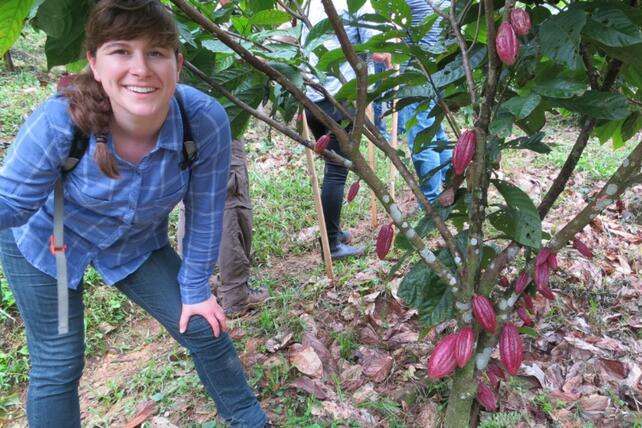What this chocolate scientist got to learn from — and teach — cacao farmers in Trinidad and Tobago

Editor's note: This article was written for The Hershey Company by chocolate scientist and College of Agricultural, Consumer and Environmental Sciences alum Allison Brown, Ph.D., who volunteered to help cacao farmers and business owners in Trinidad and Tobago maximize the value of their crops.
When I tell people I’m a chocolate scientist, they often tell me I have the best job in the world. I absolutely agree. I’m so grateful for the places my work takes me and the people I meet. In October 2022, I had the opportunity to participate in an incredibly meaningful program: I volunteered in Trinidad and Tobago, working with cacao farmers and small business owners in the cocoa supply chain to help create value-added products from cocoa through the U.S. Agency for International Development’s (USAID) Farmer-to-Farmer program.
Helping farmers
This opportunity arose after I completed my doctorate in food science with a dual title in international agriculture and development. I had written my dissertation on different aspects of fine-flavor cocoa throughout the supply chain and was contacted by Farmer-to-Farmer, a program focused on providing technical assistance to farmers in developing and transitioning countries.
The invitation to Trinidad was especially intriguing to me because of the island’s unique connection to cocoa. Cacao originated in the Amazon Basin and was traded to Mesoamerican people in what is now Mexico and Central America. Two different kinds of genetic groupings co-evolved: Forastero evolved in the Amazon Basin and was disease-resistant, whereas Criollo, which evolved in Mesoamerica, wasn’t as disease-resistant but had unique flavors. These genetic groupings were taken to Trinidad and bred together to create a hybrid genetic grouping known as Trinitario. Trinidad has had such a profound impact on cocoa that I knew I had to go and check it out.
During my experience, I spent two weeks working on a rainforest mountaintop that included some wild cacao trees (cool!). The objective was to develop value-added products for the participating farmers and small business owners in the Tri-Valley Region of Trinidad. Already, they make chocolate bars from the cacao they grow, and they wanted to develop more ways to leverage their crop and increase their income. After conducting brainstorming sessions and online searches, we devised ideas for various products. These included chocolate rum balls, a cocoa nib horchata drink spiked with rum, cocoa stout beer, and soap made with local cocoa butter. We collected all the ingredients and materials, made prototypes of the products, and tweaked the recipes and methods. The farmers and small business owners were also looking for ways to reduce sugar in their chocolate bars, an area I focus on at Hershey. We dried and pulverized different tropical fruits to use as a sweetener in their chocolate. We also discussed the importance of consumer input — consumer science was a part of my doctoral research — and shared ideas about gaining local Trinbagonian consumer insights. These ideas included hosting focus groups at a local mall and incorporating surveys as part of customer experiences in their shops and cafes.
My goal with this opportunity was to share any insights from my own journey that could assist them on theirs. This involved offering guidance through recipe sharing, equipment recommendations, beer-making demonstrations, networking, and simply providing encouragement — all aimed at empowering them to maximize the resources they have on hand.
Learning about every aspect of cacao while collaborating with the people whose lives revolve around it was an incredibly meaningful experience. I’m grateful that the Hershey Company supported and encouraged me to participate in the program.
In pursuit of purpose
I became a chocolate scientist after years of study, exploration, and research. However, the decision stemmed from an incredible discovery. After spending years working in the wine industry, I realized that I wasn’t motivated to innovate within luxury industries. Rather, developing widely accessible products was much more important to me. That’s what led me to cocoa — an industry with parallels to wine, given the shared reliance on agriculture, fermentation, processing and terroir, among other things.
The Hershey Company’s founder, Milton Hershey, had a vision to make chocolate accessible to everyone. His dedication to creating a better world is the foundation for Hershey’s purpose of making more moments of goodness. Our company’s integrity and commitment to endeavors like the Milton Hershey School drew me here. Now, I’m continually motivated by the opportunity to learn about chocolate and help make the cocoa supply chain more resilient and sustainable.
I really do have a pretty great job.
Allison Brown, Ph.D., earned her bachelor's degree from the Department of Food Science and Human Nutrition in the College of Agricultural, Consumer and Environmental Sciences at the University of Illinois Urbana-Champaign in 2007.
If you are inspired by Allison's story and eager to explore how you can make a meaningful impact in food science, contact ACES Coordinator of Undergraduate Recruitment Emily Franey at visitaces@illinois.edu to discover the majors and opportunities that await.